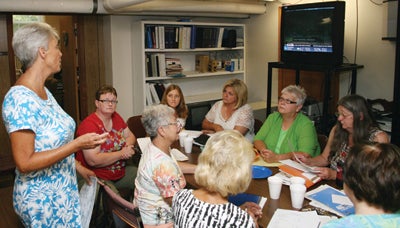County schools set to dish up free meals built with kids’ input
Published 10:37 am Monday, August 4, 2014

Photo by Abby Morris-Frye
Director of Food Services Marissa Potter, standing, talks with food services staff during a training and brainstorming session held this past week regarding anew program being adopted by the Carter County school system this year which will provide free breakfast and lunch to all K-8 students in the system.
As the days tick down to the start of school for Carter County, food services workers are gearing up for a program they’re excited about – a program that provides free meals to children.
Director of Food Services Marissa Potter and the staff of the elementary school cafeterias spent time this past week training and brainstorming for the implementation of the Community Eligibility Program for all students in grades K-8. This program is administered through the U.S. Department of Agriculture’s Food and Nutrition Service as part of the Healthy, Hunger-Free Kids Act, which is aimed at reducing child hunger.
With the adoption of the CEP program, all children in grades K-8 in Carter County schools will be able to eat breakfast and lunch for free.
“We are very excited about this opportunity,” Potter said.
The CEP program will replace the Free/Reduced Meals program for grades K-8 this year. The county’s Board of Education voted in June to adopt the program on a one year trial basis. If successful, it may be expanded to include high school students at a later time.
Potter said the key to making the program successful to Carter County is participation.
One part of that participation is getting the student’s parents or guardians to complete a form that comes with their school registration packet and return it to the school. The form helps the school qualify for the federal funds that support the program.
The second part to the participation is getting the children to eat breakfast and lunch at the school. More meals served in the school cafeteria means more federal funding for the program.
Potter said she and her staff have been working hard to increase the number of children eating at the school cafeteria by revamping the menus and offering more choices.
“We’ve changed our menus completely,” Potter said. “We are doing all the kids’ favorites.”
Potter said last year the school system did surveys with the students about the meals and the answers they received helped shape the new menus. She said she and other food services employees took the suggestions and worked within the federal healthy school meal guidelines to make sure kids had the foods they wanted, while having their nutritional needs met.
There are a few things on the new menu that Potter and other employees are excited about – TruMoo milk, Papa Murphy’s pizza and bacon.
Potter said the TruMoo milk is popular among students, who reported on their surveys that they did not like the chocolate milk the school system had been serving.
Pizza this year will be supplied by Papa Murphy’s, a company that provides fresh-made pizzas which the customer then takes home to bake.
“The pizzas will be made fresh the night before and then will be delivered to the schools where the cafeteria staff will bake them,” Potter said.
And then there’s bacon – turkey bacon, that is.
“We’ve never been able to have bacon before, so we are excited about that,” Potter said, adding the bacon can be used for sandwiches, biscuits and bacon cheeseburgers.
Potter said she and her staff have been “thinking outside the box” on ways to improve student participation with the meals – especially breakfast, which has traditionally drawn less interest from the students than lunch. She said she has been working with school principals and teachers to make it easier for the students to eat breakfast as well as working to improve the breakfasts themselves.
“We’re going to start earlier,” she said. “We are going to be doing grab-and-go breakfasts for children who get there right at start time.” The grab-and-go meals can then be taken by the student to the classroom.
Potter said studies have shown children learn better when they are well fed, so having time for them to eat breakfast will allow them to focus more on their school work instead of on the rumblings of their tummies.
School meal accounts, will remain, he said, allowing parents to be able to deposit money for their children’s meals and add money to the account so their child can purchase snacks or extra items.



